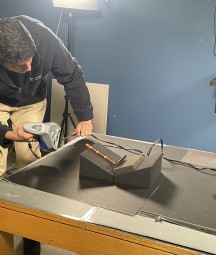The Office of Ulster King of Arms, with heraldic jurisdiction over all Ireland, was in its infancy when Bartholomew Butler, the first Ulster King of Arms granted arms to Nicholas Stanyhurst and his descendants, having been created only two years earlier. Thus it is one of the earliest original documents emanating from that Office to survive.
Nicholas Stanyhurst is typical of the earliest clients of the Office, many of whom were prominent Palesmen, officials or leading citizens of Dublin. The Stanyhurst family were established at Corduff, north of Swords in County Dublin and their loyal service to the Crown saw them benefit in the 1540s from confiscated monastic lands in counties Dublin and Meath. In his grant of arms Nicholas is described as Clerk of the Hanaper and Clerk of the Crown Chancery of Ireland (effectively a civil servant in the administration at Dublin Castle), a citizen and alderman of Dublin and sometime Mayor of Dublin (1543). His son James, a lawyer, continued the tradition of service to the Crown and city, serving as Recorder of Dublin and Speaker of the Irish House of Commons. Nicholas’ grandson Richard Stanyhurst, a noted author, scholar and diplomat, died in exile in Brussels in 1618.
At first glance of this document, the viewer notices the image of the herald wearing a tabard of the Royal Arms over his fur-trimmed garment and holding in his right hand a rod or baton. The crown upon his head identifies him as a King of Arms, one of the senior-most heralds of arms.
Closer examination of the document may provide an interesting insight into the workings of the Dublin-based Office of Arms in the early years of its life. The text is Latin, beginning with the announcement ‘Omnibus et singulis’. Contemporary texts written in the English language begin with its equivalent ‘To all Nobles and Gentill.’ What is worthy of particular note in the Stanyhurst Grant of Arms is the herald stands within a stylised initial letter ‘T’ and not the letter ‘O’ as one would expect. There are various surviving contemporary English Grants of Arms from the 1550s with similarly decorated floral margins, written in the English language and commencing with ‘To all Nobles and Gentill’. These bear an image of a bearded King of Arms in the same pose, fur-trimmed costume, tabard and rod and placed within the initial letter ‘T’. While all are similar, the Stanyhurst herald is almost identical with that depicted in the English language Grant of Arms by Gilbert Dethick, Norroy King of Arms to George Toke of Worcester dated October 1547, preserved at the College of Arms in London.
The fact that the Stanyhust grant appears in Latin but with an inconsistent initial letter suggests that the highly decorated margin, initial letter and its herald may have been produced on a blank vellum prior to the rest of the text. It further suggests the possibility that the Irish heralds may have used a pre-prepared vellum provided from England originally intended for an English language text rather than Latin.
While the Stanyhurst family were prominent in the political life of the Pale from the closing years of the fourteenth century and another of the family had been Mayor of Dublin in 1489, it is noteworthy that their arms as occur on the 1554 grant are very much in the style current among English heralds in the early to mid-sixteenth century. In addition, the Stanyhurst grant includes a crest, which were only commonly granted with arms from the early sixteenth century in England.
The date of the grant is similarly interesting. Granted on 1st day of August 1554, it bears the names of Philip and Mary, King and Queen of England and Spain. The document then must be one of the earliest in their short joint reign as the royal couple were only married one week earlier on 25 July 1554.
Donal Burke
Consultant Herald


